#Paletot
Photo

La Mode illustrée, no. 3, 17 janvier 1897, Paris. Robe anglaise ornée de galons. Robe avec corsage écossais. Robe avec paletot ajusté. Robe en drap garnie de galons. Robe en velours avec jaquette d'astrakan. Col en fourrure. Collet orné de fourrure et broderie. Paletot-sac avec revers d'hermine. Chapeau de théâtre. Modèles de chez Mmes Coussinet-Piret, rue Richer, 43. Modèles de chez Mme Colombin, rue de La Tour-d'Auvergne, 41. Ville de Paris / Bibliothèque Forney
#La Mode illustrée#19th century#1890s#1897#periodical#fashion#fashion plate#Forney#dress#plaid#paletot#coat#jacket#collar#cape#gigot#stripes#Modèles de chez#Madames Coussinet-Piret#Madame Colombin
87 notes
·
View notes
Text




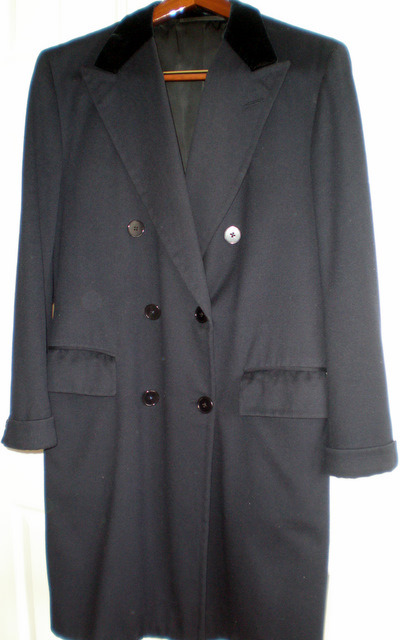

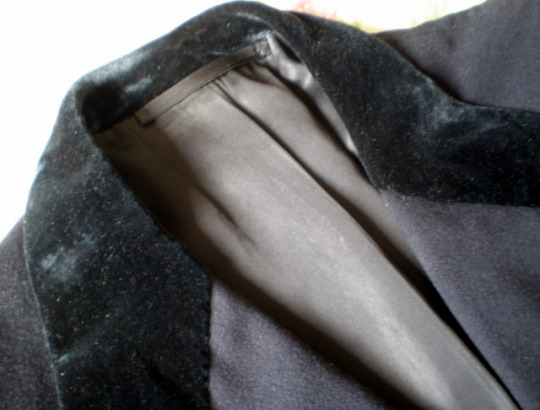

One Dress a Day Challenge
September: Bond Films
Live and Let Die / Roger Moore as James Bond
This navy blue double-breasted Chesterfield (or paletot) coat made by Cyril Castle represents the first fashion statement of the Roger Moore era. It's been called the most iconic coat of the whole film series. Possibly the coat and the conservative suit underneath were meant to make Bond seem a bit "un-hip" and stuffy-looking; but ironically, their restrained style has aged much better than the trendier clothes of other characters.
The coat is slightly shorter than a typical Chesterfield, making Moore's legs look longer. Some notable features include the peaked lapels, velvet collar, and turned-back "gauntlet" cuffs with a single button. (Photos of the actual coat come from this article found through the Wayback Machine.)
Other notable features of the outfit are the black gloves and the Royal Navy regimental tie. Moore leaned into dressing like a former naval officer more than any other Bond actor.
#live and let die#bond film costumes#roger moore#one dress a day challenge#one dress a week challenge#movie costumes#1973 movies#1973 films#1970s fashion#1970s style#classic menswear#james bond#james bond films#bond james bond#007#cyril castle#paletot#outerwear#chesterfield coat#chesterfield#70s fashion#70s style#live & let die#roger moore era
10 notes
·
View notes
Text
Patricia Ligouis Fort - J’ai accroché un oiseau à ma fenêtre
J’ai accroché un oiseau à ma fenêtreIl chante dans ma têteTu l’entendras peut-êtreLes jours de tempêtePousser sa chansonnette
J’ai accroché un oiseau au revers de ton paletotIl chante en fa, en doPour que tu te souviennes des motsQue l’amour égraineDans mon cœur de p’tit moineau
Photo de Levent Simsek

View On WordPress
0 notes
Text
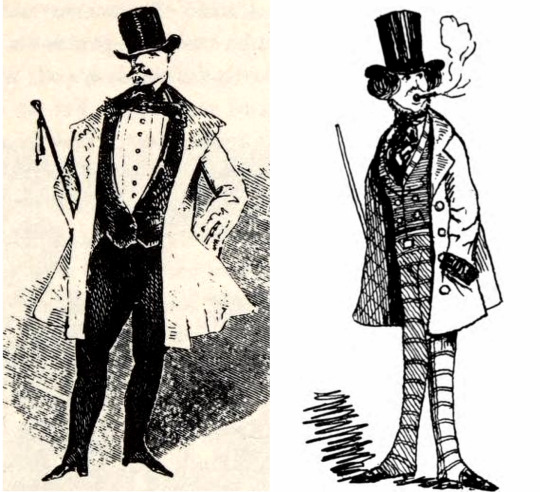
At left, the type of 1840s man that many people want, looking dashing in his evening costume and with the fashionable barrel chest and defined waist of his breed.
At right, a more typical example of the 1840s man that you will find at discount prices: note the striped trousers, huge paletot coat, and cigar.
This is the difference that proper vetting of your 19th century man can make! Of course, many people are happy with the Gent on the right and will gladly indulge his fashion habits and smoking.
#is the 19th century man okay#mid 19th century#1840s#archibald henning#punch magazine#victorian#early victorian era#fashion#class#gents
176 notes
·
View notes
Text
1908 (2 Feb issue) La Mode Illustrée - Paletot et robe de demi-saison Modeles de Mlle Louise Piret. From bibliotheques-specialisees.paris.fr/; fixed flaws & spots w Pshop 1734X2388.
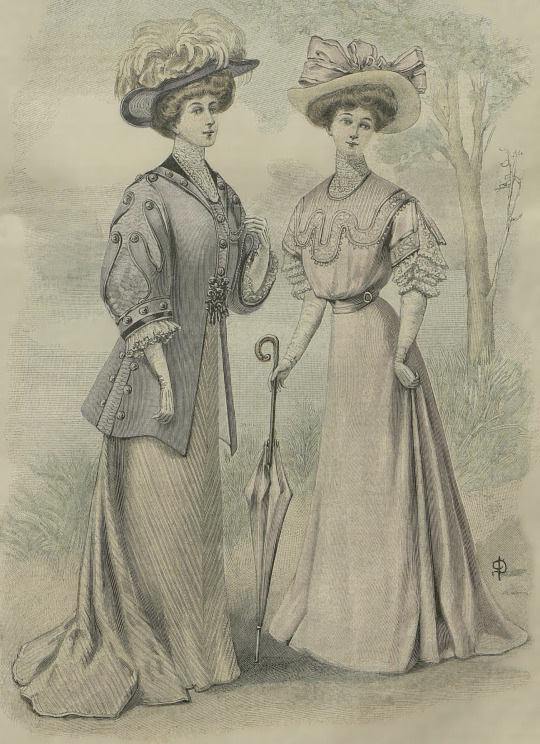
#1908 fashion#1900s fashion#Belle Époque fashion#Edwardian fashion#Louise Piret#afternoon dress#feathered hat#pompadour coiffure#under-bodice#clerical neckline#jacket#three-quarter length sleeves#close skirt#parasol#pouter pigeon bodice#waist band
30 notes
·
View notes
Text
In honour of our favourite group of men finally entering the story, I'll fish out 1-2 quotes I love about each man from this chapter.
Enjolras
"Enjolras was a charming young man, who was capable of being terrible [...] One would have said, to see the pensive thoughtfulness of his glance, that he had already, in some previous state of existence, traversed the revolutionary apocalypse."
Best introductory line to any character in literature by far, if I say so myself. I also like the reincarnation implication in the second half, framing Enjolras not as a person but rather the recurring phenomenon of revolution.
Combeferre
"He read everything, went to the theatres, attended the courses of public lecturers, learned the polarization of light from Arago, grew enthusiastic over a lesson [...] He declared that the future lies in the hand of the schoolmaster, and busied himself with educational questions."
I adore the fact that he strives to educate himself on everything, and that he loves the process of learning as well. And I agree wholeheartedly that the future is in education! My dream man.
Jean Prouvaire
"His name was Jehan, owing to that petty momentary freak which mingled with the powerful and profound movement whence sprang the very essential study of the Middle Ages [...] He spoke softly, bowed his head, lowered his eyes, smiled with embarrassment, dressed badly, had an awkward air, blushed at a mere nothing, and was very timid. Yet he was intrepid."
I love his little Middle Ages hyperfixation, go Jehan! And of course, we get a slight foreshadow of his fate at the end of his description, where he is said to be brave, despite everything.
Feuilly
"[Feuilly] had but one thought, to deliver the world. He had one other preoccupation, to educate himself; [...] The protest of right against the deed persists forever. The theft of a nation cannot be allowed by prescription. These lofty deeds of rascality have no future. A nation cannot have its mark extracted like a pocket handkerchief."
Feuilly's description is really similar to Enjolras' (minus the waxing about his looks), and I find it interesting Hugo adds the last part under Feuilly rather than anyone else's. Someone smarter than me can probably give a better analysis as to why.
Courfeyrac
"Beneath the apparent similarities of the exterior mind, the difference between him [...] There was in Tholomyès a district attorney, and in Courfeyrac a paladin. [...] Enjolras was the chief, Combeferre was the guide, Courfeyrac was the centre. The others gave more light, he shed more warmth"
Hugo loves his parallelism and so do I. Courfeyrac as a nice Tholomyès is a good way to efficiently describe him, and the last part of his description is so iconic to our triumvirate characterisation that I had to put it in.
Bahorel
"Every time that he passed the law-school, which rarely happened, he buttoned up his frock-coat,—the paletot had not yet been invented,—and took hygienic precautions. [...] In reality, he had a penetrating mind and was more of a thinker than appeared to view."
Bahorel is so funny; I too want to live my life as a student for 11 years without the need for graduating. I like that Hugo points out his intelligence too, its easy to reduce him to just a comic character, but theres a reason he's in this group, guys!
Bossuet
Bossuet was a gay but unlucky fellow. His specialty was not to succeed in anything. As an offset, he laughed at everything. At five and twenty he was bald. [...] He was poor, but his fund of good humor was inexhaustible. He soon reached his last sou, never his last burst of laughter.
This is such a fun and vivid character description, Hugo really manages to bring Bossuet to life. I love a man who can laugh at himself and while it's sad to see him be used to his unfortunate circumstances, I admire his humour about it all.
Joly
"What he had won in medicine was to be more of an invalid than a doctor. At three and twenty he thought himself a valetudinarian, and passed his life in inspecting his tongue in the mirror. He affirmed that man becomes magnetic like a needle [...] Otherwise, he was the gayest of them all. All these young, maniacal, puny, merry incoherences lived in harmony together, and the result was an eccentric and agreeable being"
He and Bossuet have the most fun descriptions ever, I'm jealous. The magnetism part is hilarious and I love that Hugo makes a point in saying that despite it all, he is still a happy-go-lucky man, similar to the unlucky, but jovial Bossuet.
Grantaire
"Grantaire was a man who took good care not to believe in anything. Moreover, he was one of the students who had learned the most during their course at Paris; he knew that the best coffee was to be had at the Café Lemblin, and the best billiards at the Café Voltaire [...] However, this sceptic had one fanaticism [...] it was a man: Enjolras. [...] No one loves the light like the blind man. The dwarf adores the drum-major. The toad always has his eyes fixed on heaven. Why? In order to watch the bird in its flight. Grantaire, in whom writhed doubt, loved to watch faith soar in Enjolras. [...] their name is a sequel, and is only written preceded by the conjunction and; and their existence is not their own; it is the other side of an existence which is not theirs. Grantaire was one of these men. He was the obverse of Enjolras."
This is embarrassingly long. But look, I LOVE how contradictory Grantaire's character is, even in his own, third-person omniscient description. He doesn't care about anything, but he knows and loves Paris so intimately that he learned of it the most. He doesn't believe in anything, but he believes wholeheartedly in one man. And like Jehan, his fate is foreshadowed at the end. He only exists if Enjolras exists. Without the latter, there is no former, and vice versa.
#les mis#les mis letters#les mis daily#les amis#les amis de l'abc#syrup ramble#syrup talks about lit
135 notes
·
View notes
Text
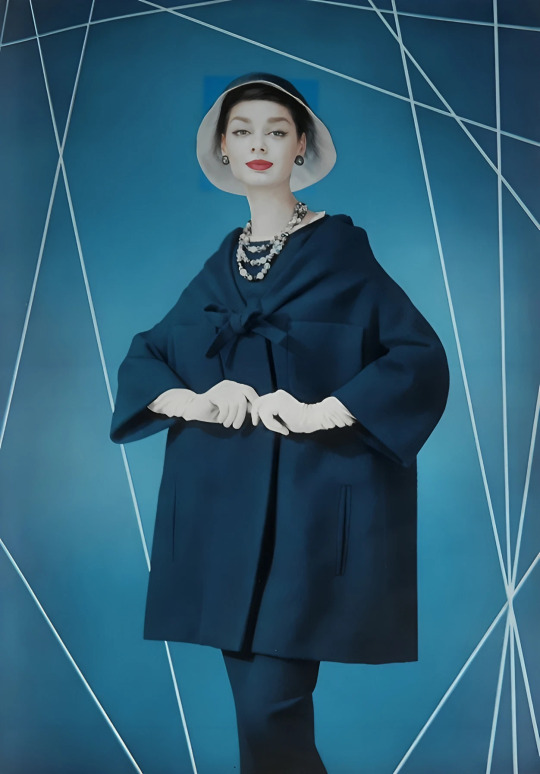
Ligne "Libre"
Christian Dior Haute Couture Collection Spring/Summer 1957.
Jacky Mazel wears the three-quarter pea coat. Draped neckline held by a knot and showing the receding movement of the shoulders, high patch pockets and slit pockets.
Christian Dior Collection Haute Couture Printemps/Été 1957.
Jacky Mazel porte le paletot caban trois quart. Encolure drapé retenue par un nœud et accusant le mouvement fuyant des épaules, poches appliquées hautes et poches fendues.
Photo Frères Séeberger. (Femme Chic 1er trimestre 1957)
#haute couture#christian dior#ligne libre#fashion 50s#1957#spring/summer#printemps/été#jacky mazel#frères séeberger#femme chic magazine
22 notes
·
View notes
Photo

Patrons Favoris (c.1905) Paletot
48 notes
·
View notes
Text

An illustration by Paul Gavarni to accompany Albert Smith's essay "The Casino" in Gavarni in London (1849).
[Albert] Smith titled the essay that accompanied Gavarni’s image simply “The Casino,” but his text refers to Laurent’s Casino, and the periodical press of the period shows that Laurent’s was a specific, popular venue situated just off the Strand to the east of Trafalgar Square in central London. [...]
It is a gent that Gavarni depicts enjoying a sherry-cobbler at Laurent’s Casino. In his accompanying essay, Smith records that gents were the “overwhelming class” frequenting the casino; elsewhere he observed that “Gentism” was at “a rampant pitch” there. The man’s slightly long, curled hair, his ring, the large buttons on his double-breasted sac coat, and his short cane and cigar are the gent’s signature accessories in the late 1840s, and would have been immediately recognizable. Descriptions of this urban type had been widely disseminated in the literary and visual culture of the day.
— Jo Briggs, “Gavarni at the Casino: Reflections of Class and Gender in the Visual Culture of 1848″ July 2011, Victorian Studies 53(4):639-64. (Google Drive link)
Compare Gavarni's handsome and elegant Gent to a more typical specimen in a John Leech cartoon from 1847:

Or an illustration in Albert Smith's The Natural History of the Gent (1847):

The wide paletot coat, the very narrow hat brim, the cigar, and the comically large tie pins connected by a chain are all signatures of a "Gent."
Writing about class and visual culture in 1840s Britain, Jo Briggs observes:
Despite the mocking attitude of Smith and others who depicted the gent in textual or visual form, their humor defused the tensions surrounding this upstart figure. [...] The widespread discussion of the gent must therefore be understood as part of a broader preoccupation with the classification of novel and parvenu urban types in visual and literary culture at this time. But this preoccupation stemmed from the fact that, by reproducing the styles and mannerisms of the middle and upper classes, the gent drew attention to the performative aspects of class.
Gents formed a specific subsection of the urban lower-middle classes: young men, without dependents, in skilled jobs that paid well enough to leave a little spare cash for small luxuries, cheap ready-made clothes, and low-brow entertainments. Their jobs were not physically demanding and they worked shorter hours than many. In the evenings they were free to act out a fantasy of a life of leisure, showing off their loud clothes while trying to appear indifferent and aloof.
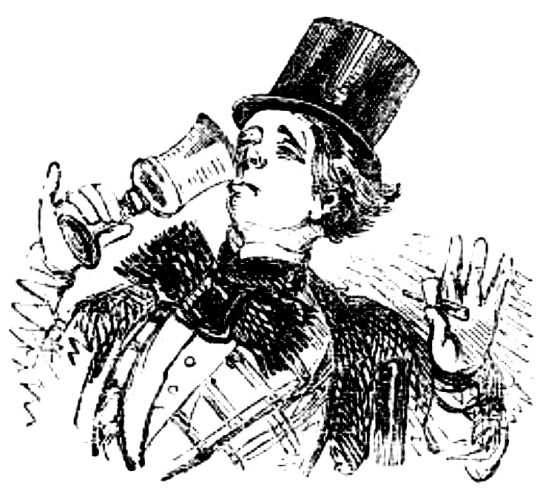
Nice Joinville necktie.
#Eighteen-Forties Friday#1840s#fashion history#visual culture#paul gavarni#albert smith#john leech#early victorian era#fashion#men's fashion#gents#jo briggs#class#historical men's fashion#victorian#neckwear#gavarni in london
77 notes
·
View notes
Text
Non passi lo straniero!
Roma, 5 luglio 1932
«La confederazione nazionale dei sindacati fascisti professionisti e artisti, allo scopo di contribuire all’eliminazione delle parole straniere della lingua in uso, ha richiamato la particolare attenzione delle dipendenti organizzazioni sindacali degli autori e scrittori e dei giornalisti (categoria la cui azione in matèria è da ritenersi di notèvole importanza ed efficàcia anche nei riguardi del parlare corrente) sul seguente elenco di voci straniere e di corrispondenti italiane o italianizzate:
«Berceau: chiosco; bonne: bambinaia; brochure: opùscolo; en brochure: non rilegato; buvette: bar; cafè chantant: caffè concerto; châlet: casina; charme: fàscino; châssis: telaio; chèque: assegno; klakson: clacson; corvée: corvé (nell’uso militare), sfacchinata, ecc.; dancing: sala da ballo; feuilleton: appendice; frack: marsina; gilet: panciotto; golf: farsetto, maglioncino, maglione; masseuse: massaggiatrice; omelette: frittata; paletot: cappotto, pastrano; parvenu: rifatto, arrivato; pendant: riscontro, simmetria; pied à terre: piede a terra; redingote: finanziera; régisseur: regista; rez de chaussée: pianterreno; silhouette: sagoma, figurina; suite: série; surtout: soprabito; tabarin: tabarino; taxi: tassi; vermouth: vermut; vis à vis: di fronte; viveur: vitaiolo. »
«La confederazione professionisti e artisti ha vivamente raccomandato ai dirigenti i sindacati che l’eliminazione delle voci straniere secondo l’elenco di cui sopra avvenga non solo negli atti e pubblicazioni ufficiali, ma in ogni manifestazione dell’attività giornalistica e letterària».
A. Panzini, Grammatica italiana [1933], Palermo, Sellerio, 1999
4 notes
·
View notes
Photo

La Mode illustrée, no. 16, 19 avril 1885, Paris. Paletot en faille française (devant). Mantelet en lainage (devant). Paletot en faille française (dos). Ville de Paris / Bibliothèque Forney
#La Mode illustrée#19th century#1800s#1880s#1885#periodical#fashion#fashion plate#Forney#dress#mantle#coat#paletot#bustle#devant et dos#lace
22 notes
·
View notes
Text
Papillon
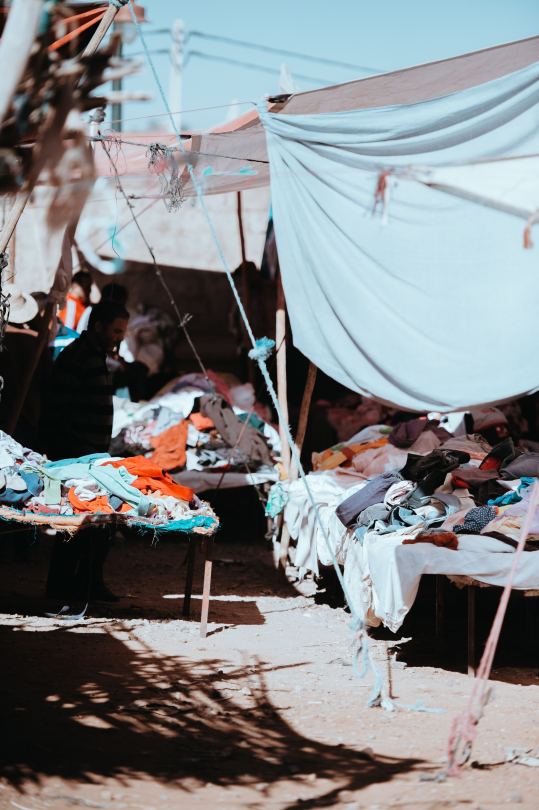
Une écharpe papillon, deux paletots sauterelle et un slip moustique
Petit butin du chineur de fripes du mercredi
Daltonien et amoureux des mots entomologiques
Qui transforme chaque pièce en morceaux de poésie
11 notes
·
View notes
Text

"Paletot-Sac" de Balenciaga en mouflon de Gerondeau vert photographié par Irving Penn pour Vogue US (1950) à l'exposition "Lisa Fonssagrives-Pen - Icône de Mode" à la Maison Européenne de la Photographie (MEP), Paris, avril 2024.
2 notes
·
View notes
Text

...always ready to smash a windowpane, then to tear up the pavement, then to demolish a government, just to see the effect of it...
Every time that he passed the law-school, which rarely happened, he buttoned up his frock-coat—the paletot had not yet been invented—and took hygienic precautions.
7 notes
·
View notes
Text
Guarda "CLAUDIO BAGLIONI - POSTER" su YouTube.
youtube
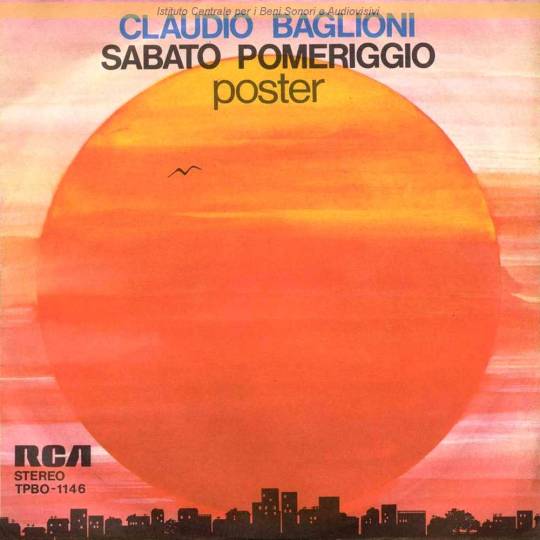


Seduto con le mani in mano
Sopra una panchina fredda del metrò
Sei lì che aspetti quello delle 7:30
Chiuso dentro il tuo paletot
Un tizio legge attento le istruzioni
Sul distributore del caffè
E un bambino che si tuffa dentro a un bignè
E l'orologio contro il muro
Segna l'una e dieci da due anni in qua
Il nome di questa stazione
È mezzo cancellato dall'umidità
Un poster che qualcuno ha già scarabocchiato
Dice "vieni in Tunisia"
C'è un mare di velluto ed una palma
E tu che sogni di fuggire via
E andare lontano lontano
Andare lontano lontano
E da una radiolina accesa
Arrivano le note di un'orchestra jazz
Un vecchio con gli occhiali spessi un dito
Cerca la risoluzione a un quiz
Due donne stan parlando
Con le braccia piene di sacchetti dell'Upim
Ed un giornale è aperto
Sulla pagina dei films
E sui binari quanta vita che è passata
E quanta che ne passerà
E due ragazzi stretti stretti
Che si fan promesse per l'eternità
Un uomo si lamenta ad alta voce
Del governo e della polizia
E tu che intanto sogni ancora
Sogni sempre sogni di fuggire via
E andare lontano lontano
Andare lontano lontano
Sei lì che aspetti quello delle 7:30
Chiuso dentro il tuo paletot
Seduto sopra una panchina fredda del metrò.
4 notes
·
View notes
Text
1908 (October) Les Modes - Grand paletot de loutre par Ström - art by René. From gallica.bnf.fr; fixed spots & flaws w Pshop 740X1905. Grand paletot de loutre translates to large otter coat. The palette name may be due to the small number of large round attachments instead of a larger number of smaller buttons. Marine otters almost went extinct, as did many species of birds with beautiful plumage, to satisfy fashion.

#1908 fashion#1900s fashion#Belle Époque fashion#Edwardian fashion#Ström#feathered hat#fur coat#collar#high neckline#long sleeves
5 notes
·
View notes